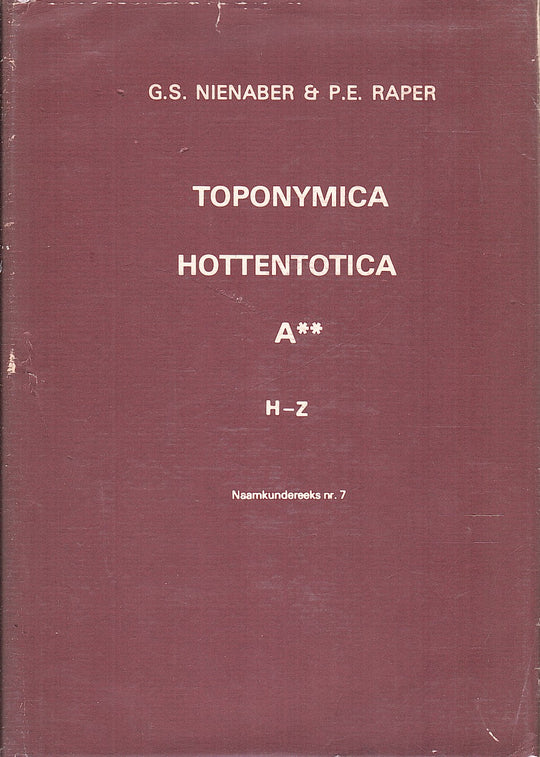eng
Forbes followed Beutler's travel route on the foot and fixed naguij / ride outside of kick, Collins's description leaves no doubt, nor the maps: Naguij / Rij, Cahoon, Kahoon / A is the current Nahoon. That N and K in Old Cape can allophone, it is a language fact, cf. o.a. Hott 180-1, or think of an example like N-Faith next to K-Arou for 'chameleon' in Old Cape; Also see 5 D 5. The CA and Ka- is therefore equating with Beutler's post and current Nahoon. We regard them as interchanges of exactly the same word part. We further notice the constancy of the vowel, at all the -a. As far as the second syllable is concerned: It is also a language fact that G- and H allophone, that Beutler's -Goe - is the same as the other's -Hoo, cf. 5 c. . C / KA-HOO, Nagu and current Nahoo is interchangea. They are geographically and toponsimically equal. The difference is in the exit, the -zij orRij against the -n or -na, but it is not the main part. To summarize: As far as the audio queue is concerned, we can work with the certainties that the first member has a vowel -a- and an Anlaut K or N, and the second member a vowel ǀ u] or [u : L with an Anlaut G or H. Then there are only one verdict on the meaning in our sources, viz. those of Chase, 'to fight'. We can therefore go out of the meaning and see which Khoekhoian word in the name sufficiently agree. Then it seems convincing enough to see the Nahoon's oldest exchange ruling 'Kahoon' the Nama Word Kha- Drawing 'Fight' (Kr.-R. 1969 NW 212). About the Hoon, Good, 'we are uncertain. Maybe as at Krenz FK 1976 farmer recording 'ǃ Ka = stechen, ho = hit,ǃ Ka-ho = der Stich Traf'. Whatever, it is linguistically reconcilable to seek the meaning in at least the first component for 'combat point', 'Failure farm', as it is for our converted.
afr
Forbes het Beutler se reisroete op die voet gevolg en Nagoezij/rij buite kyf vasgestel, Collins se beskrywing laat geen twyfel oor nie, ook nie die landkaarte nie: Nagoezij/rij, Cahoon, Kahoon/a is die huidige Nahoon. Dat n- en k- in Ou-Kaaps kan allofoneer, dit is 'n taalfeit, vgl. o.a. HOTT 180-1, of dink aan 'n voorbeeld soos n-arrou naas k-arou vir 'verkleurmannetjie' in Ou-Kaaps; kyk ook 5 D 5. Die Ca- en Ka- is dus gelyk te stel met Beutler se Na- en die huidige Na- van Nahoon. Ons beskou hulle as wisseluitsprake van presies dieselfde woorddeel. Daarin merk ons verder die konstantheid van die klinker, by almal die -a-. Wat die tweede lettergreep betref: dit is ook ’n taalfeit dat g- en h- allofoneer, dat Beutler se -goe- dieselfde is as die ander se -hoo-, vgl. 5 C 4. As verder onthou word dat Beutler se -oe- volgens die Hollandse verklanking te waardeer is, die -oo- van die ander weer volgens die Engelse waardes te lees is, dan merk ons ook in hierdie lettergreep die konstantheid van die klinker. C/Ka-hoo, Nagoe- en die huidige Nahoo- is wisseluitsprake. Hulle is geografies en toponimies gelyk. Die verskil is in die uitgang, die -zij of -rij teenoor die -n of -na, maar dit is nie die hoofdeel nie. Om op te som: wat die klankbousel betref, kan ons met die sekerhede werk dat die eerste lid ’n klinker -a- het en 'n anlaut k- of n-, en die tweede lid ’n klinker ǀu] of [u:l met 'n anlaut g- of h-. Dan is daar in ons bronne net een uitspraak oor die betekenis, nl. die van Chase, 'om te veg'. Ons kan dus uitgaan van die betekenis en kyk watter Khoekhoense woord daarin met die naam voldoende ooreenkom. Dan lyk dit oortuigend genoeg om in die Ka- van Nahoon se oudste wisseluitspraak 'Kahoon' die Namawoord kha- te sien, be- tekenende 'veg' (Kr.-R. 1969 NW 212). Oor die -hoon, goe- ens„ is ons on- seker. Miskien dan soos by Krenz FK 1976 Boer Aantekening 'ǃka = stechen, ho = treffen, ǃKa-ho = der Stich traf'. Hoe ook al, dit is taalkundig versoen- baar om in Ka/Nahoon in minstens die eerste komponent die betekenis te soek vir 'Gevegsplek', 'Bakleiplaas', soos dit vir ons oorgelêwer is.




